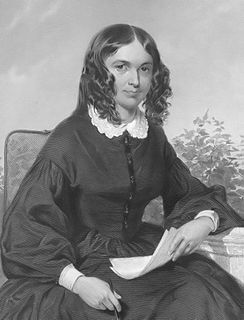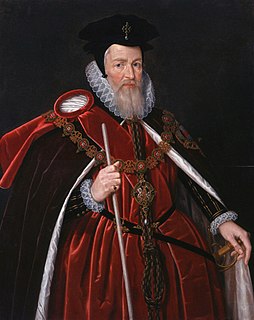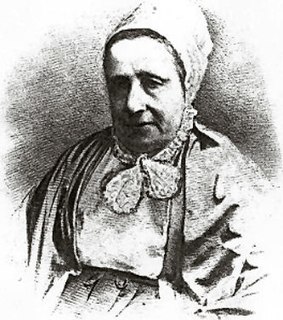Related Research Articles

Anne Brontë was an English novelist and poet, and the youngest member of the Brontë literary family.

Elizabeth Barrett Browning was an English poet of the Victorian era, popular in Britain and the United States during her lifetime.

Mary Anning was an English fossil collector, dealer, and palaeontologist who became known around the world for the discoveries she made in Jurassic marine fossil beds in the cliffs along the English Channel at Lyme Regis in the county of Dorset in Southwest England. Anning's findings contributed to changes in scientific thinking about prehistoric life and the history of the Earth.

William Cecil, 1st Baron Burghley was an English statesman, the chief adviser of Queen Elizabeth I for most of her reign, twice Secretary of State and Lord High Treasurer from 1572. In his description in the Encyclopædia Britannica Eleventh Edition, Albert Pollard wrote, "From 1558 for forty years the biography of Cecil is almost indistinguishable from that of Elizabeth and from the history of England."

Letitia Elizabeth Landon was an English poet and novelist, better known by her initials L.E.L.

Robert William Elliston was an English actor and theatre manager.

Hannah More was an English religious writer, philanthropist, poet and playwright in the circle of Johnson, Reynolds and Garrick, who wrote on moral and religious subjects. Born in Bristol, she taught at a school her father founded there and began writing plays. She became involved in the London literary elite and a leading Bluestocking member. Her later plays and poetry became more evangelical. She joined a group opposing the slave trade. In the 1790s she wrote Cheap Repository Tracts on moral, religious and political topics, to distribute to the literate poor. Meanwhile, she broadened her links with schools she and her sister Martha had founded in rural Somerset. These curbed their teaching of the poor, allowing limited reading but no writing. More was noted for her political conservatism, being described as an anti-feminist, a "counter-revolutionary", or a conservative feminist.

Agnes Strickland was an English historical writer and poet. She is particularly remembered for her Lives of the Queens of England.

Dame Mary Douglas, was a British anthropologist, known for her writings on human culture and symbolism, whose area of speciality was social anthropology. Douglas was considered a follower of Émile Durkheim and a proponent of structuralist analysis, with a strong interest in comparative religion.
Elizabeth FitzGerald was the first wife of Lucas Plunket, who succeeded as Baron Killeen in 1613, and who in due course became the 1st Earl of Fingall in 1628. They lived at Killeen Castle, County Meath in Ireland. She was a daughter of Henry FitzGerald, 12th Earl of Kildare, and therefore sister to Bridget, the Countess of Tyrconnell and wife of Prince Rory O'Donnell, 1st Earl of Tyrconnell.
Young Royals is a series of novels for children by Carolyn Meyer based on the early lives of multiple royalties such as English and French royalty. Books in the series are mostly about the English Tudors, such as: Mary, Bloody Mary (1999); Beware, Princess Elizabeth (2001); Doomed Queen Anne (2002); and Patience, Princess Catherine (2004). The French books in the series are Duchessina (2007), about the life of Catherine de' Medici, and The Bad Queen: Rules and Instructions for Marie-Antoinette (2010). The most recent titles in the series are: The Wild Queen: The Days and Nights of Mary, Queen of Scots (2012); Victoria Rebels (2013), about Queen Victoria of the British Empire; and Anastasia and Her Sisters (2013), about the daughters of Tsar Nicholas of Russia, specifically Anastasia.
Alison Weir is a British author and public historian. She primarily writes about the history of English royal women and families, in the form of biographies that explore their historical setting. She has also written numerous works of historical fiction.

Priscilla Wakefield, neePriscilla Bell was an English Quaker philanthropist. Her writings cover feminist economics and scientific subjects and include children's non-fiction.
Ann Hawkshaw was an English poet. She published four volumes of poetry between 1842 and 1871.

Mary Palmer was a British author from Devon who wrote Devonshire Dialogue, once considered the "best piece of literature in the vernacular of Devon." She was the mother of painter Theophila Gwatkin and sister of the artists Sir Joshua Reynolds and Frances Reynolds and of the pamphleteer Elizabeth Johnson.

Elizabeth Kirby (1823–1873) and Mary Kirby were successful English writers and illustrators of books for children and books on natural science. Mary Kirby is known particularly for leading the crowd-sourced Flora of Leicestershire and Elizabeth for her children's books. They both had a lifelong writing partnership that popularised science. Mary is thought to be one of the first British woman to publish a scientific study of the flora of her county in the nineteenth century.

Mary Elizabeth Mohl or Mary Elizabeth Clarke was a British writer who was known as a salon hostess in Paris. She was known by her nickname of "Clarkey". She was admired for her independence and conversation. She eventually married the orientalist Julius von Mohl. She was an ardent Francophile, a feminist, and a close friend of Florence Nightingale. She wrote about her interest in the history of women's rights.

Sarah Fitton was an Irish writer and botanist. Assisted by her sister Elizabeth, Sarah Fitton wrote Conversations on Botany (1817), framed as a series of conversations between a mother and her son on botany and the principles of Linnaean taxonomy. The book focuses on the identification and use of plants in a domestic setting, and influenced the popularity of botany as a field of scientific study for women. Color engravings differ between editions of the book.

Elizabeth Boyd was an English writer and poet who supported her family by writing novels, poetry, a play, and a periodical. She also wrote under the noms de plume Louisa or Eloisa. Boyd is one of three known members of the Shakespeare Ladies Club.

Susanna Corder was an educationist and Quaker biographer.
References
- 1 2 Elizabeth Lee, ‘Rundall, Mary Ann (d. 1839)’, rev. Rosemary Mitchell, Oxford Dictionary of National Biography, Oxford University Press, 2004 accessed 6 Dec 2014
- ↑ Emmons, edited by Anne Curzan, Kimberly (2004). Studies in the history of the English language II unfolding conversations. Berlin: Mouton de Gruyter. ISBN 3110897660.
{{cite book}}:|first1=has generic name (help)